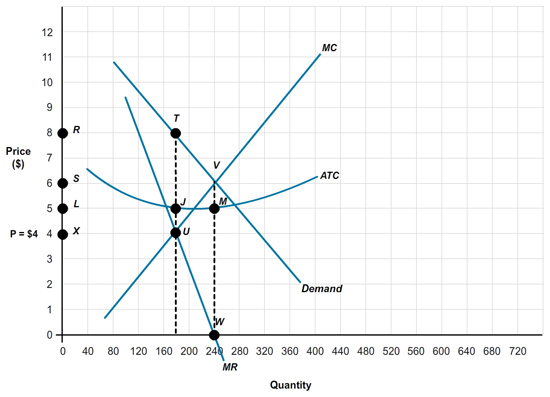Chapter 1. Chapter 9
Step 1
Question
Consider the following graph for a firm that can choose either to behave as a competitive firm or act as a monopolist. The marginal cost (MC) curve, the marginal revenue (MR) curve, and the demand (D) curve corresponding to each level of output (Q) and price (P) are shown in the graph below.

Under monopoly, the firm would follow the pricing rule f3bUpKP0p8XUIEWIqGh6TyRMKrK2YWCrCqyTXWvBeHuYA8aCM1U1PW32d3g=, which is found at point tBGzYHDPa+Gvoo9gJEfn0QSjEjC8CAMqfEEnYqF3b8TzAo9C.
Step 2
Question

The firm would produce +2vVfw3o60nrncW8Y9KYQg== units at a price of CqkCH24oO+Rz1kmS.
Step 3
Question

Profit would be depicted by the DCq5PG7kOdCCTiTMtGZhazf4NZNJ1I9MS0qBlglODQM= bounded by hGVRboHW3xN8DHHHinsYRT7DIcELoH7MBHp2QptSDdF+xgOMfunzU7ikVMmAGDagtILwubCAu+xbPiDX.
Step 4
Question

Deadweight loss would be depicted by the UijqFlG0qkFKY2kunoVxJe1ZCuvLqvGNm4J0sSrjZO0= bounded by 4jsDTcrw/bmAmT2HcqikrA6BN0tOOa7/DVqkITHGAniAYA9Igh3YSi7ba/4=.
Step 5
Question

How much is the firm’s revenue? $NoCziNECjTLsg+fbA0Kz6A==
Step 6
Question

How much are the firm’s costs? $K7HQa/VBR3s=
Step 7
Question

How much are the firm’s profits? $q9tzWM7vpIc=
Step 8
Question

Under perfect competition, the firm would follow the pricing rule BhXXjgLTJgUNNROqlmNiI1V8TfaO/enS5hVhcjwgQuofIO1D+dlHnIwcR8o=, which is found at point jQKnd8s68tAodBJSgcw1IIKqiZXOzRnax+/t/0S8fgUROP+j.
Step 9
Question

The firm would produce /jUkf4/4SNgw1fGMeXpyMA== units at a price of pIvn+w37bSAxzNuO.
Step 10
Question

In the long run, profit would be VoY6qbUX72b/Wq4rEoQwe/OI+DejpTkbMCQmWyYsNnpTLkRaPM+4Z1k5oP6YyZzP.
Step 11
Question

Deadweight loss would be iCN4rMpOSnhWbQyXcPnJtlNMsw3nhOxVEiVaIPoh9RMZpZmwVTgckTWG+mwEJrseNkdoch8q3UpR0UhpNUF8G7r0b9aVqssLpS+d3shJ4B/3zDM+rbLcAuJsxqVVsNBTl8gU02/0THNbfURMZ94WFeNbYX6LzL4xMVTvtQ==.
Step 12
Question

How much is the firm’s revenue? $wO8Wi54A9X8wgsC4y512Kg==
Step 13
Question

How much are the firm’s short-run costs? $J/r6VDFzhMh2t8kMm5ww9g==
Step 14
Question

How much are the firm’s short-run profits? $Dd41BsRvdFs=